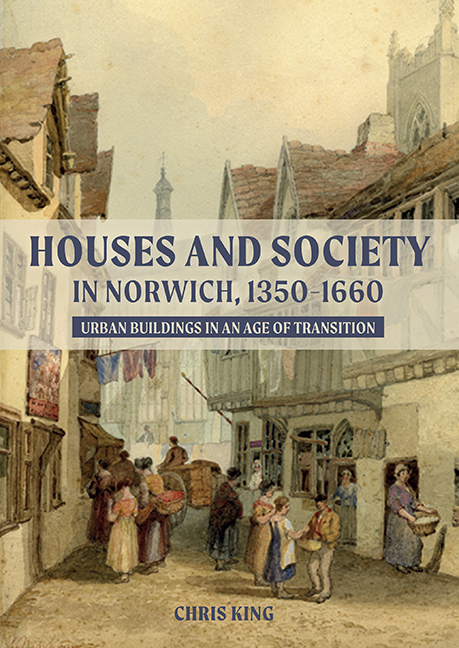Book contents
- Frontmatter
- Dedication
- Contents
- List of plates and figures
- List of tables
- Acknowledgements
- List of Abbreviations
- 1 Urban rebuildings, urban transitions
- 2 Norwich, 1350–1660: continuity and change in an English provincial city
- 3 Medieval merchants’ houses, c.1350–1540
- 4 Early modern merchants’ houses, c.1540–1660
- 5 The urban elite: domestic space, social identity and civic authority
- 6 Medieval houses and the urban ‘great rebuilding’
- 7 Houses of the ‘middling sort’: buildings and the use of space
- 8 Housing the urban poor and immigrant communities
- Conclusions
- Glossary
- Bibliography
- Index
- Plate Section
1 - Urban rebuildings, urban transitions
Published online by Cambridge University Press: 23 October 2020
- Frontmatter
- Dedication
- Contents
- List of plates and figures
- List of tables
- Acknowledgements
- List of Abbreviations
- 1 Urban rebuildings, urban transitions
- 2 Norwich, 1350–1660: continuity and change in an English provincial city
- 3 Medieval merchants’ houses, c.1350–1540
- 4 Early modern merchants’ houses, c.1540–1660
- 5 The urban elite: domestic space, social identity and civic authority
- 6 Medieval houses and the urban ‘great rebuilding’
- 7 Houses of the ‘middling sort’: buildings and the use of space
- 8 Housing the urban poor and immigrant communities
- Conclusions
- Glossary
- Bibliography
- Index
- Plate Section
Summary
Prologue: Houses and society in an English provincial city
ON 25th April 1507 the ‘fair city’ of Norwich, England's largest and wealthiest provincial urban centre, was struck by a terrible calamity when a great fire broke out in the dense network of streets and lanes on the south bank of the river Wensum. The majority of the city's houses were constructed of timber framing and clay walling with thatched roofs, which were quickly consumed; only the flint masonry churches and public buildings, and the stone and brick houses belonging to the city's wealthy merchants, escaped the conflagration. The fire burned for four days, causing major destruction in a sweeping arc from the cathedral precinct and Tombland in the east to St Margaret's parish in the west. The city had no respite once the flames were quenched, for, later that same year, in June 1507, a second fire broke out in the northern quarter of the city, ‘Over the Water’, devastating a further group of densely occupied parishes.
The impact of the fires was recorded by Francis Blomefield, the celebrated eighteenth- century Norfolk antiquarian, who stated that 718 houses were destroyed (Blomefield 1806 [1745], III, 182–3). This has been calculated as representing at least 40 per cent of the city's housing stock, and a great deal of personal property and merchandise must also have been lost (Evans and Carter 1985, 77–8). It was the most serious provincial urban fire ever recorded in early modern England, second only to the 1666 Great Fire of London (Jones et al. 1984, 5). However, the townspeople were well placed to provide an effective and co-ordinated response to these traumatic events. At the beginning of the sixteenth century Norwich was a thriving city with between 8000 and 9000 inhabitants; unlike many other towns it had experienced growth and prosperity in the late medieval period as a centre for the worsted cloth trade, with a flourishing commercial network extending through the wider region of East Anglia to London and across the North Sea to the Low Countries. Since 1404 the city had been governed as an independent county under a corporation of mayor and aldermen, advised by a common council elected by the citizenry.
- Type
- Chapter
- Information
- Houses and Society in Norwich, 1350–1660Urban Buildings in an Age of Transition, pp. 1 - 36Publisher: Boydell & BrewerPrint publication year: 2020



